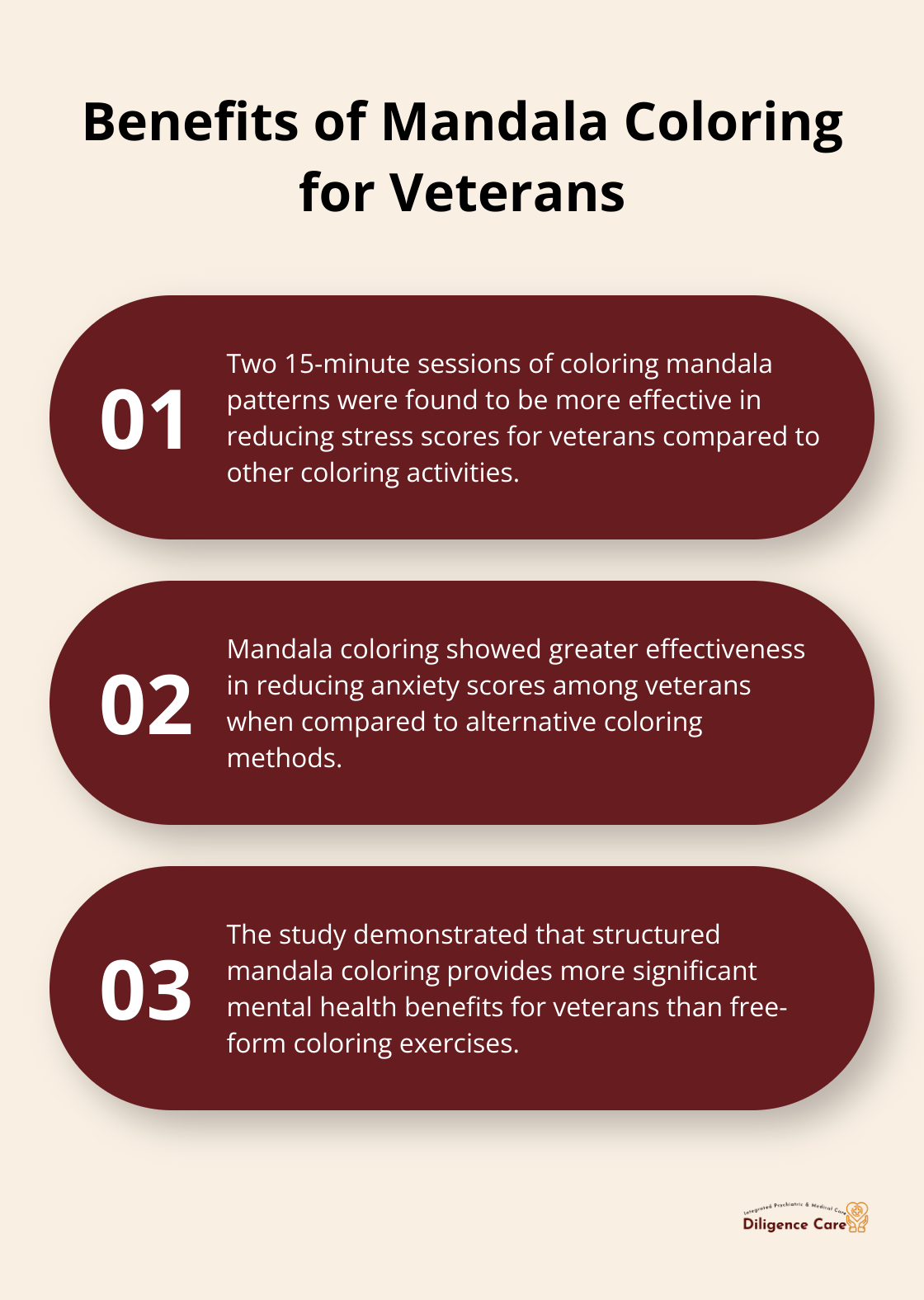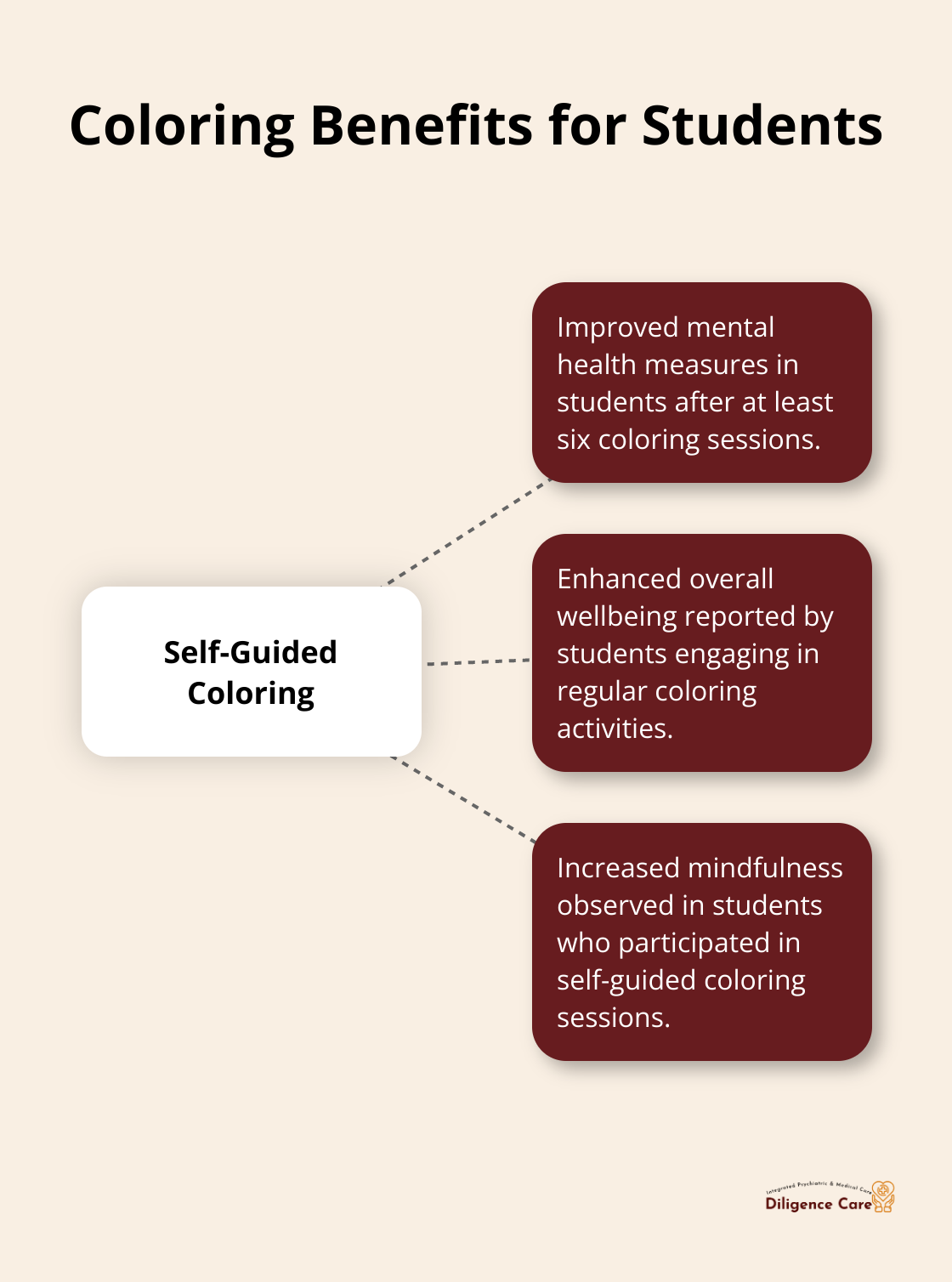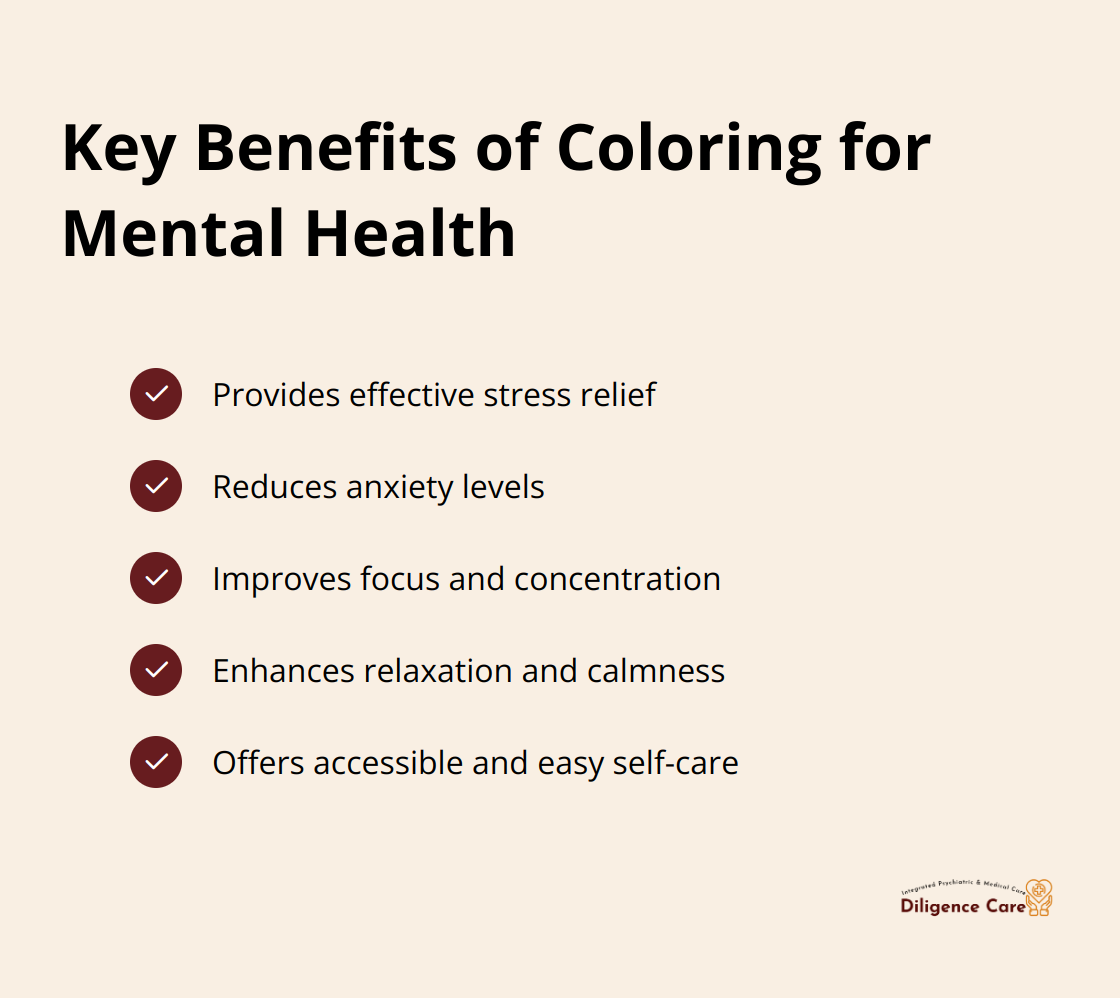
Stress-Relief Coloring Pages for Mental Health Self-Care
At Diligence Integrated Care, we’ve seen firsthand how simple activities can have a profound impact on mental health.
One such activity that’s gained popularity is using mental health self-care coloring pages. This creative outlet offers a unique blend of relaxation and focus, providing a much-needed break from daily stressors.
In this post, we’ll explore the science behind coloring for stress relief and share practical tips to incorporate this soothing practice into your self-care routine.
The Brain on Coloring: A Scientific Perspective
Neuroscience of Coloring
Coloring can help people achieve a meditative state, which is known to alleviate stress and anxiety. When you color, your brain enters a state akin to meditation. This effect likely stems from the repetitive motions and focus required, which activate the frontal lobe (the brain’s center for organization and problem-solving).
Measurable Mental Health Benefits
The benefits of coloring extend beyond mere relaxation. A 2012 study published in the Journal of the American Art Therapy Association found that coloring pre-drawn coloring pages reduced anxiety to a greater extent compared to other activities.
Coloring vs. Traditional Art Therapy
While both offer benefits, coloring provides unique advantages. Unlike traditional art therapy (which often requires guidance from a trained therapist), coloring allows for independent practice. This accessibility makes it an excellent option for daily stress relief.
Expert Insights
Mental health professionals often recommend coloring to patients as a complement to their treatment plans. “Coloring provides a structured creative outlet that can help those with anxiety or depression,” explains Dr. Bolanle Oluwadara, MD. This simple yet effective practice offers a valuable addition to comprehensive mental health care.
Integrating Coloring into Treatment
For those interested in exploring coloring as part of their mental health journey, many resources exist. An integrated approach ensures that coloring becomes an effective component of an overall care plan. Mental health providers can offer guidance on how to incorporate this practice into daily routines for maximum benefit.
As we move forward, let’s explore the various types of coloring pages designed specifically for stress relief and their unique benefits.
Exploring Stress-Relief Coloring Pages
Mandala Magic
Mandala designs, with their circular patterns and intricate details, offer effective stress relief. A study found that two 15-minute sessions of coloring mandala patterns were more effective in reducing veterans’ anxiety and stress scores compared to free-form coloring. These symmetrical designs (originating from Hindu and Buddhist traditions) symbolize the universe and wholeness. Many people experience a meditative state when coloring mandalas, similar to the effects of mindfulness practices.
Dr. Bolanle Oluwadara, MD, observes, “Patients often report feeling more centered and calm after coloring mandalas. The repetitive nature of these designs seems to have a soothing effect on the mind.”

Nature’s Nurture
Nature-inspired coloring pages tap into the inherent human connection with the natural world. These designs often feature flowers, trees, landscapes, and animals. Coloring these pages can evoke feelings of peace and tranquility associated with being in nature. Research suggests that the sounds of nature can lower stress and irritability, and a small study found benefits for medical students engaging with nature-based therapy.
Bernadette Akpengbe, PMHNP-BC, FNP-BC, recommends nature-themed coloring pages to patients dealing with anxiety. “Engaging with natural imagery, even through coloring, can help reduce stress levels and promote a sense of calm,” she explains.
Geometric Journeys
Abstract and geometric patterns offer a different kind of stress relief. These designs challenge the mind to focus on shapes and patterns, potentially redirecting thoughts away from stressors. The precision required in coloring these intricate designs can engage those who find comfort in order and structure.
Eric Efuetngu, DNP, FNP-C, APRN, suggests, “For patients who enjoy problem-solving, geometric coloring pages can provide a satisfying mental exercise while also promoting relaxation.”
Personalized Approach
When choosing coloring pages for stress relief, consider your personal preferences and what resonates with you. Some people find mandala designs most calming, while others prefer the familiarity of nature scenes or the challenge of geometric patterns. Try different styles to discover what works best for your mental health self-care routine.
Professional Guidance
For those interested in exploring coloring as a stress-relief technique, mental health professionals can offer valuable insights. A trained therapist or counselor can help integrate this practice into your overall mental health care plan, ensuring you get the most benefit from this simple yet effective self-care tool.
Now that we’ve explored various types of stress-relief coloring pages, let’s discuss how to incorporate coloring into your self-care routine effectively.
How to Create Your Coloring Sanctuary
Crafting Your Coloring Space
The environment you color in plays a crucial role in maximizing relaxation. Create a calming coloring corner at home with comfy seating, soft lighting, and organized supplies. Add cozy touches like plants and calming music to enhance your experience.
Dr. Bolanle Oluwadara, MD, suggests, “Your coloring space should be a retreat from the world. Make it a place where you can truly unwind and focus on the present moment.”
Selecting Your Coloring Arsenal
The tools you use can make a big difference in your coloring experience. While colored pencils are a popular choice, don’t be afraid to experiment with different mediums. Gel pens can add a vibrant pop of color, while markers offer smooth, bold strokes. Some people find that watercolor pencils provide a unique, blendable effect that’s particularly relaxing.
Bernadette Akpengbe, PMHNP-BC, FNP-BC, recommends, “Choose tools that feel comfortable in your hand and produce colors that resonate with you. The physical sensation of coloring should be as enjoyable as the visual result.”
Mindful Coloring Techniques
To harness the stress-relieving power of coloring, incorporate mindfulness techniques. Before you begin, take a few deep breaths to center yourself. As you color, focus on the sensation of the tool moving across the paper, the colors blending and contrasting, and the gradual completion of the image.
Coloring significantly improved all measures of mental health, wellbeing and mindfulness in students who completed at least six sessions of self-guided coloring.

Eric Efuetngu, DNP, FNP-C, APRN, advises, “Pay attention to your thoughts as you color. If you notice your mind wanders to stressful topics, gently bring your focus back to the coloring process. This practice can help train your brain to manage stress more effectively in daily life.”
Integrating Coloring with Other Self-Care Practices
Coloring doesn’t have to be an isolated activity. Consider combining it with other stress-relief techniques to create a comprehensive self-care routine. For example, you might start your coloring session with a short meditation or end it with some gentle stretching exercises.
Some patients successfully pair coloring with aromatherapy, using calming scents like lavender or chamomile to enhance relaxation. Others find that coloring while listening to a guided relaxation audio can deepen the stress-relieving effects.
The goal is to create a self-care practice that works for you. Experiment with different combinations and pay attention to what feels most beneficial. With time and practice, you’ll develop a coloring routine that not only relieves stress but also becomes a cherished part of your day.
Final Thoughts
Mental health self-care coloring pages offer a powerful tool for stress relief and improved well-being. Scientific research supports the effectiveness of coloring in reducing anxiety and promoting relaxation. Many individuals find that regular coloring sessions help them feel more centered and better equipped to handle daily stressors.
Coloring provides a simple yet effective way to enhance mental health, accessible to anyone regardless of artistic skill. Local bookstores and online platforms offer a wide variety of adult coloring books and printable options (including free downloadable pages from mental health organizations). Incorporating coloring into your self-care routine can contribute to a calmer, more focused state of mind.

For comprehensive mental health care that integrates various therapeutic approaches, visit Diligence Integrated Care. Our team of experienced professionals can help develop a personalized treatment plan tailored to your needs. Grab those colored pencils, find a comfortable spot, and let the soothing strokes of color guide you towards improved mental well-being.











